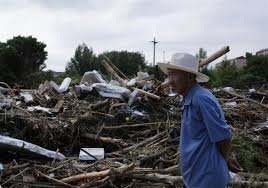Heavy rains, flooding kill at least 34 people in and near Beijing

Heavy rains and severe flooding have killed at least 34 people in Beijing and nearby regions. Torrents of water swept through towns and villages, destroyed roads, and forced tens of thousands from their homes.
Torrential Rain Overwhelms Beijing
Earlier this week, northern China witnessed one of its heaviest rainfalls in decades. In Miyun district of Beijing, rain gauges recorded up to 543 mm (about 21 inches) in a few days. That’s nearly a full year’s worth of rain.
This sudden downpour flooded roads and valleys. Rivers overflowed. Landslides blocked access to several mountain communities. The city’s drainage systems couldn’t handle the volume, especially in older or hilly areas.
Dozens Dead and Thousands Evacuated
Officials confirmed 30 deaths in Beijing. Most of those occurred in Miyun district. Two people died in Yanqing, another suburb. In Hebei province, a landslide in Luanping county killed four people. Rescue teams are still searching for eight people who are missing.
The government evacuated over 80,000 people in Beijing. In Tianjin’s Jizhou district, another 10,000 people had to leave their homes. Many families lost everything as the floodwaters swept through their neighborhoods.
Homes, Roads, and Power Lines Destroyed
The damage is widespread. Roads collapsed, bridges broke, and entire vehicles disappeared under the water. Emergency teams reported serious damage in over 130 villages. Many residents still have no access to electricity or mobile networks.
Floodwaters damaged the Miyun Reservoir, Beijing’s largest water source. Water levels reached their highest point since 1959. Authorities began controlled releases to ease the pressure, warning downstream residents about the rising danger.
Emergency Response in Full Force
In response to the disaster, the Chinese government declared a top-level flood emergency. Schools shut down. Construction sites paused. Tourist areas closed. Rescue teams, including soldiers and emergency workers, rushed to affected areas.
The central government sent rescue experts and 50 million yuan (around $7 million) in aid to Hebei province. Helicopters, boats, and drones are helping to deliver supplies and evacuate those trapped.
Shelters have opened in schools and public buildings. Volunteers are helping distribute food, water, and blankets to survivors. In many areas, community groups stepped in before official teams could arrive.
Climate Change Behind the Chaos?
Experts say events like these will happen more often. As the climate warms, storms grow stronger. Warmer air holds more moisture, causing sudden and intense rainfall.
Cities like Beijing are especially vulnerable. Rapid development has replaced open land with concrete. That prevents rainwater from soaking into the ground. Without proper drainage systems, floods spread faster and do more damage.
Beijing and other cities have started building “sponge cities.” These urban areas absorb and store rain. But progress is slow, and the recent floods show that more action is needed.
Personal Stories from the Flood
Liu Hong, a resident of Miyun, shared her story. “The water entered our home so fast. We didn’t have time to grab anything,” she said. “We climbed to the roof and waited for help.”
In Hebei, many farmers lost their crops. Families were separated during evacuations. Some people are still searching for missing relatives. Despite the devastation, many are helping each other recover.
What Comes Next?
As the waters begin to recede, the focus now turns to recovery. Crews are clearing roads, restoring power, and reconnecting communication lines. Medical teams are also on alert to prevent disease outbreaks.
The government promised to investigate the disaster. Officials want to know whether flood warnings came in time and if more could have been done.
This tragedy highlights the urgent need for better flood preparation and climate resilience. Cities must improve infrastructure and ensure early-warning systems work for all residents — not just those in central areas.






